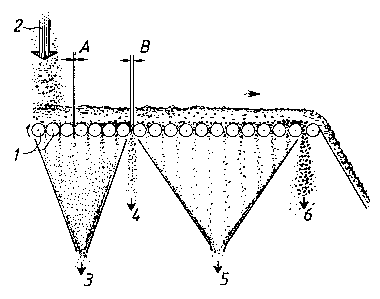Some of the information on this Web page has been provided by external sources. The Government of Canada is not responsible for the accuracy, reliability or currency of the information supplied by external sources. Users wishing to rely upon this information should consult directly with the source of the information. Content provided by external sources is not subject to official languages, privacy and accessibility requirements.
Any discrepancies in the text and image of the Claims and Abstract are due to differing posting times. Text of the Claims and Abstract are posted:
| (12) Patent: | (11) CA 2168898 |
|---|---|
| (54) English Title: | REMOVING IMPURITIES FROM PULVERIZED OR CHIPPED MATERIAL |
| (54) French Title: | ELIMINER LES IMPURETES DES MATERIAUX PULVERISES OU DECHIQUETES |
| Status: | Term Expired - Post Grant Beyond Limit |
| (51) International Patent Classification (IPC): |
|
|---|---|
| (72) Inventors : |
|
| (73) Owners : |
|
| (71) Applicants : |
|
| (74) Agent: | MARKS & CLERK |
| (74) Associate agent: | |
| (45) Issued: | 2006-05-16 |
| (22) Filed Date: | 1996-02-06 |
| (41) Open to Public Inspection: | 1996-08-16 |
| Examination requested: | 2003-01-06 |
| Availability of licence: | N/A |
| Dedicated to the Public: | N/A |
| (25) Language of filing: | English |
| Patent Cooperation Treaty (PCT): | No |
|---|
| (30) Application Priority Data: | ||||||
|---|---|---|---|---|---|---|
|
The invention relates to a method and apparatus for screening pulverized or chip material, such as fibers or wood chips, free from impurities. The material to be screened is fed onto a roil set formed by a number of adjacent, essentially parallel rolls (1) and is brought to an advantageous movement with the help of said rolls (1), whereby material particles of highest density drift downward closest to the surfaces of the rolls and that the material fraction closest to the roll surfaces can escape the rolls via a gap (B) a width essentially larger than the gap width (A) of the preceding roll pairs.
L'invention concerne une méthode et un appareil pour tamiser des matériaux pulvérisés ou déchiquetés, tels que des fibres ou des copeaux de bois, pour les rendre libres de toute impureté. Les matériaux à tamiser sont apportés à un ensemble de rouleaux formé par plusieurs rouleaux adjacents, essentiellement parallèles (1) et sont amenés à un mouvement avantageux à l'aide des dits rouleaux (1), dans lequel les particules de matériau de la densité la plus élevée dérivent vers le bas, au plus près des surfaces des rouleaux et les fractions de matériau les plus proches des surfaces des rouleaux peuvent s'échapper des rouleaux par un espace (B) dont la largeur est essentiellement plus grande que la largeur de l'espace (A) de la paire de rouleaux précédents.
Note: Claims are shown in the official language in which they were submitted.
Note: Descriptions are shown in the official language in which they were submitted.

2024-08-01:As part of the Next Generation Patents (NGP) transition, the Canadian Patents Database (CPD) now contains a more detailed Event History, which replicates the Event Log of our new back-office solution.
Please note that "Inactive:" events refers to events no longer in use in our new back-office solution.
For a clearer understanding of the status of the application/patent presented on this page, the site Disclaimer , as well as the definitions for Patent , Event History , Maintenance Fee and Payment History should be consulted.
| Description | Date |
|---|---|
| Inactive: Expired (new Act pat) | 2016-02-06 |
| Inactive: Office letter | 2012-04-04 |
| Inactive: Reversal of will be deemed expired status | 2012-03-28 |
| Letter Sent | 2012-02-06 |
| Letter Sent | 2009-10-19 |
| Letter Sent | 2009-10-19 |
| Letter Sent | 2009-10-19 |
| Inactive: Correspondence - Transfer | 2009-08-27 |
| Grant by Issuance | 2006-05-16 |
| Inactive: Cover page published | 2006-05-15 |
| Inactive: IPC from MCD | 2006-03-12 |
| Inactive: IPC from MCD | 2006-03-12 |
| Inactive: IPC from MCD | 2006-03-12 |
| Pre-grant | 2006-02-27 |
| Inactive: Final fee received | 2006-02-27 |
| Letter Sent | 2005-11-02 |
| Notice of Allowance is Issued | 2005-11-02 |
| Notice of Allowance is Issued | 2005-11-02 |
| Inactive: Approved for allowance (AFA) | 2005-08-08 |
| Amendment Received - Voluntary Amendment | 2005-06-27 |
| Inactive: S.30(2) Rules - Examiner requisition | 2004-12-30 |
| Inactive: Status info is complete as of Log entry date | 2003-02-21 |
| Letter Sent | 2003-02-21 |
| Inactive: Application prosecuted on TS as of Log entry date | 2003-02-21 |
| All Requirements for Examination Determined Compliant | 2003-01-06 |
| Request for Examination Requirements Determined Compliant | 2003-01-06 |
| Application Published (Open to Public Inspection) | 1996-08-16 |
There is no abandonment history.
The last payment was received on 2006-01-23
Note : If the full payment has not been received on or before the date indicated, a further fee may be required which may be one of the following
Please refer to the CIPO Patent Fees web page to see all current fee amounts.
Note: Records showing the ownership history in alphabetical order.
| Current Owners on Record |
|---|
| SUNDS DEFIBRATOR LOVIISA OY |
| DIEFFENBACHER PANELBOARD OY |
| Past Owners on Record |
|---|
| AARNE LAATIKAINEN |